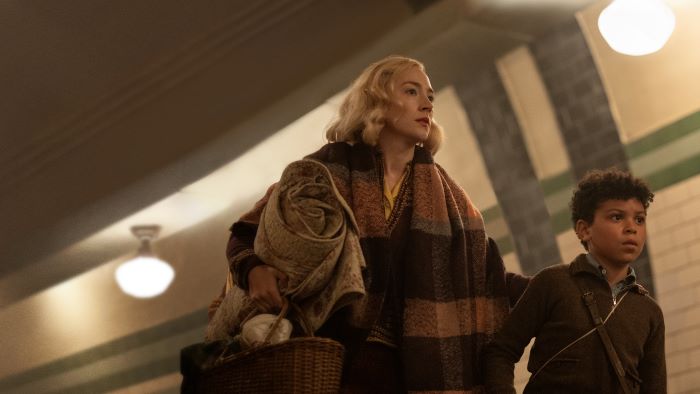After its North American premiere at the 62nd New York Film Festival, Blitz is a must-see experience for anyone seduced by old-fashioned epics. Written and directed by Steve McQueen as a snapshot of three days during the Blitz (the World War II bombing of Britain by Nazi Germany), so much happens within that short span of days that you’d think it’s a story covering years.
The historical episode is told through the experience of a White mother and her biracial son. Rita Hanway (Saoirse Ronan), like many other London mothers, sends her son off at the train station as part of the evacuation of children, moving them to safer non-industrial areas. George (Elliott Heffernan) is a 10-year-old boy forced to obey the decision. The other members of his small family are his cat Ollie and his grandfather, Gerald (Paul Weller). Whether in his East End neighborhood or on the train, he is bullied for his racial background and absent Black father (who was deported before he was born). It’s easy to understand why he doesn’t want to leave the safe space of home. George boards the train, though denying his mother the chance for a warm goodbye after declaring he hates her. The gesture deeply affects Rita, who runs, banging on the train window, trying to get her son to look at her. The sullen boy remains resolute in his insult. The cruelty weighs on George too, leading him to jump off the moving train and plan a return to London to reunite with his mother.
In the city, Rita is one of many women working in factories assembling bombs, and also a respected member of her community (she’s chosen to sing on a live BBC radio broadcast from the factory). When she learns that George has not arrived at his destination, a day has already passed, and the emotional core of the film rests on whether a reunion between them will be possible as the city turns into hell every night. Ronan’s immense talent as an actress has been proved many times before, but here—shining blonde hair, piercing blue eyes, lips perpetually painted in red—she leaves a new kind of impression. She has never been gazed at with such hypnotic admiration, the one once reserved for capturing the stars of classic Hollywood.
McQueen’s new film can be considered his most conventional and accessible work. Given the scale, that’s more than a compliment. As the director, he displays impeccable technical mastery. As the screenwriter, McQueen conveys important messages on racism, xenophobia, anti-Semitism, and ableism that still resonate today. They are reflections on how even the “right” side of the war committed injustices and fostered divisions. There’s a preachy aspect in some of these scenes that works better when you consider they are experienced through the eyes of a child. However, the devastation represented is far from fodder for a fairy tale for children.
The British filmmaker is no stranger to ambitious period pieces, as proven by his Oscar-winning 12 Years a Slave set before the Civil War or his methodical observation of Thatcher–era England in Hunger and the five-film anthology Small Axe. His approach to history is visceral, violent, and at odds with sentimentality, not unlike his more modern dramas (Shame, Widows) that aren’t afraid to explore complicated, often unlikable characters facing dark situations. So, it’s a pleasant and ambivalent surprise to see him operate in a more classical and benevolent mode, with a sensitivity more fitting for the best of Spielberg. It may remind viewers of similar stylistic directorial departures like Steven Soderbergh’s King of The Hill or John Boorman’s Hope and Glory.
However, the shift in style aligns with the novelistic nature of the film, in the literary tradition of the bildungsroman, where an innocent character—George—experiences life lessons that will define him as an adult. After several encounters with various characters who either help him (a Nigerian watchman who takes him to a shelter) or exploit him (a gang of ruffians pulled straight from a Dickens novel), and a few nerve-wracking moments (the flooding of a subway tunnel), George witnesses the consequences of war more than almost any other English child of his era. Later, when he stumbles upon an improvised puppet show where other children smile and become absorbed, the first thing he notices is the shoes of the man operating behind. George’s vision of the world has been altered forever.
Watching Blitz, however, feels like there is a missing glue fusing George’s emotional journey in the broader, larger historical canvas (think of the narrative and emotional completeness of epics like Schindler’s List or Titanic). What it shares in abundance with other equally exuberant historical dramas (from Gone with the Wind to The English Patient) is the impeccable and successive execution of set pieces. The apocalyptic bombings and the euphoric staging of singing and dancing sequences form an immersive universe that holds your attention for two hours. Whatever cohesion and emotional closure the movie lacks may be an intentional subversion on the part of the director. Still, there’s something undeniably artificial about mesmerizing historical postcards like Blitz, which look beautifully staged, even in relation to what’s terrifying and horrible on-screen.

















Leave A Comment